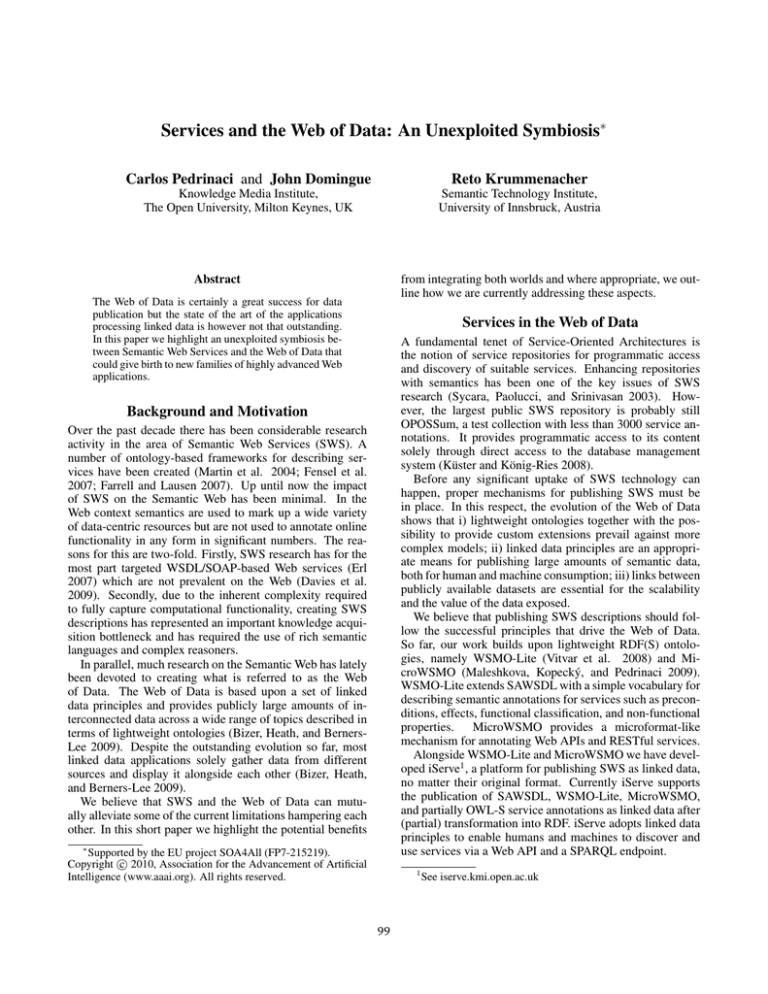
Services and the Web of Data: An Unexploited Symbiosis∗
Carlos Pedrinaci and John Domingue
Reto Krummenacher
Knowledge Media Institute,
The Open University, Milton Keynes, UK
Semantic Technology Institute,
University of Innsbruck, Austria
from integrating both worlds and where appropriate, we outline how we are currently addressing these aspects.
Abstract
The Web of Data is certainly a great success for data
publication but the state of the art of the applications
processing linked data is however not that outstanding.
In this paper we highlight an unexploited symbiosis between Semantic Web Services and the Web of Data that
could give birth to new families of highly advanced Web
applications.
Services in the Web of Data
A fundamental tenet of Service-Oriented Architectures is
the notion of service repositories for programmatic access
and discovery of suitable services. Enhancing repositories
with semantics has been one of the key issues of SWS
research (Sycara, Paolucci, and Srinivasan 2003). However, the largest public SWS repository is probably still
OPOSSum, a test collection with less than 3000 service annotations. It provides programmatic access to its content
solely through direct access to the database management
system (Küster and König-Ries 2008).
Before any significant uptake of SWS technology can
happen, proper mechanisms for publishing SWS must be
in place. In this respect, the evolution of the Web of Data
shows that i) lightweight ontologies together with the possibility to provide custom extensions prevail against more
complex models; ii) linked data principles are an appropriate means for publishing large amounts of semantic data,
both for human and machine consumption; iii) links between
publicly available datasets are essential for the scalability
and the value of the data exposed.
We believe that publishing SWS descriptions should follow the successful principles that drive the Web of Data.
So far, our work builds upon lightweight RDF(S) ontologies, namely WSMO-Lite (Vitvar et al. 2008) and MicroWSMO (Maleshkova, Kopecký, and Pedrinaci 2009).
WSMO-Lite extends SAWSDL with a simple vocabulary for
describing semantic annotations for services such as preconditions, effects, functional classification, and non-functional
properties.
MicroWSMO provides a microformat-like
mechanism for annotating Web APIs and RESTful services.
Alongside WSMO-Lite and MicroWSMO we have developed iServe1 , a platform for publishing SWS as linked data,
no matter their original format. Currently iServe supports
the publication of SAWSDL, WSMO-Lite, MicroWSMO,
and partially OWL-S service annotations as linked data after
(partial) transformation into RDF. iServe adopts linked data
principles to enable humans and machines to discover and
use services via a Web API and a SPARQL endpoint.
Background and Motivation
Over the past decade there has been considerable research
activity in the area of Semantic Web Services (SWS). A
number of ontology-based frameworks for describing services have been created (Martin et al. 2004; Fensel et al.
2007; Farrell and Lausen 2007). Up until now the impact
of SWS on the Semantic Web has been minimal. In the
Web context semantics are used to mark up a wide variety
of data-centric resources but are not used to annotate online
functionality in any form in significant numbers. The reasons for this are two-fold. Firstly, SWS research has for the
most part targeted WSDL/SOAP-based Web services (Erl
2007) which are not prevalent on the Web (Davies et al.
2009). Secondly, due to the inherent complexity required
to fully capture computational functionality, creating SWS
descriptions has represented an important knowledge acquisition bottleneck and has required the use of rich semantic
languages and complex reasoners.
In parallel, much research on the Semantic Web has lately
been devoted to creating what is referred to as the Web
of Data. The Web of Data is based upon a set of linked
data principles and provides publicly large amounts of interconnected data across a wide range of topics described in
terms of lightweight ontologies (Bizer, Heath, and BernersLee 2009). Despite the outstanding evolution so far, most
linked data applications solely gather data from different
sources and display it alongside each other (Bizer, Heath,
and Berners-Lee 2009).
We believe that SWS and the Web of Data can mutually alleviate some of the current limitations hampering each
other. In this short paper we highlight the potential benefits
∗
Supported by the EU project SOA4All (FP7-215219).
c 2010, Association for the Advancement of Artificial
Copyright Intelligence (www.aaai.org). All rights reserved.
1
99
See iserve.kmi.open.ac.uk
Since knowledge-acquisition has been a significant bottleneck for SWS technologies, we are devoting much effort to creating tools that support users in the annotation
of services by leveraging the Web of Data as a source of
background knowledge (e.g., the Web API annotation tool
SWEET (Maleshkova, Pedrinaci, and Domingue 2009)).
The acquisition of service annotations is in this way simplified while at the same time links between service annotations and the Web of Data are established, paving the way
for linked data application developers to locate interesting
services in a simple manner (e.g., based on the input and
output types of services).
opment of advanced linked data applications. The vision
sketched herein has been further refined and discussed in
(Pedrinaci, Domingue, and Krummenacher 2009) including
ideas from prior research on Knowledge Engineering and
Artificial Intelligence, and additional architectural concerns
such as the need for supporting data updates and notifications have to be investigated. These are in our opinion essential features for the systematic engineering of complex
intelligent systems over the Web of Data.
References
Bizer, C.; Heath, T.; and Berners-Lee, T. 2009. Linked
Data - The Story So Far. Int’l Journal on Semantic Web
and Information Systems.
Davies, J.; Domingue, J.; Pedrinaci, C.; Fensel, D.;
Gonzalez-Cabero, R.; Potter, M.; Richardson, M.; and
Stincic, S. 2009. Towards the Open Service Web. BT
Technology Journal 26(2).
Erl, T. 2007. SOA Principles of Service Design. Prentice
Hall.
Farrell, J., and Lausen, H. 2007. Semantic Annotations for
WSDL and XML Schema. W3C Recommendation.
Fensel, D.; Lausen, H.; Polleres, A.; de Bruijn, J.; Stollberg, M.; Roman, D.; and Domingue, J. 2007. Enabling
Semantic Web Services: The Web Service Modeling Ontology. Springer.
Küster, U., and König-Ries, B. 2008. Towards Standard
Test Collections for the Empirical Evaluation of Semantic
Web Service Approaches. Int’l Journal of Semantic Computing 2(3):381–402.
Maleshkova, M.; Kopecký, J.; and Pedrinaci, C. 2009.
Adapting SAWSDL for Semantic Annotations of RESTful
Services. In Beyond SAWSDL Workshop at OTM.
Maleshkova, M.; Pedrinaci, C.; and Domingue, J. 2009.
Supporting the creation of semantic restful service descriptions. In Workshop on Service Matchmaking and Resource
Retrieval in the Semantic Web at ISWC.
Martin, D.; Burstein, M.; J., H.; Lassila, O.; McDermott,
D.; McIlraith, S.; Paolucci, M.; Parsia, B.; Payne, T.; Sirin,
E.; Srinivasan, N.; and Sycara, K. 2004. OWL-S: Semantic
Markup for Web Services. W3C Member Submission.
Pedrinaci, C.; Domingue, J.; and Krummenacher, R.
2009. On the integration of services with the web
of data.
Technical Report kmi-09-06, Knowledge
Media Institute, The Open University.
Available at
http://kmi.open.ac.uk/publications/pdf/kmi-09-06.pdf.
Phuoc, D. L.; Polleres, A.; Hauswirth, M.; Tummarello,
G.; and Morbidoni, C. 2009. Rapid Prototyping of Semantic Mash-Ups through Semantic Web Pipes. In World Wide
Web Conf., 581–590.
Sycara, K.; Paolucci, M.; and Srinivasan, A. A. N. 2003.
Automated discovery, interaction and composition of Semantic Web services. Web Semantics 1(1):27–46.
Vitvar, T.; Kopecky, J.; Viskova, J.; and Fensel, D. 2008.
WSMO-Lite Annotations for Web Services. In 5th European Semantic Web Conf.
Services for the Web of Data
Services as well-defined, independent and distributed pieces
of functionality are a very powerful means for developing
distributed systems (Erl 2007), which, when it comes to an
environment like the Web, appears as a highly appropriate (if
not necessary) construct. Services can contribute to the Web
of Data in two fundamental ways. First, services can enable
the provisioning of additional linked data dynamically by
exposing legacy systems. For instance, there is a large body
of information behind RESTful services, or offered by sensors that still remain within controlled silos and expressed
in formats that do not follow linked data principles. Execution frameworks based on annotations of existing Web APIs
and WSDL services would enable a new means for unleashing valuable data on demand. Second, we previously highlighted the fact that most linked data applications are essentially providing integrated views of distributed data without
exploiting the deeper value of the Web of Data. Application
developers could conveniently combine services at runtime
to carry out computations as simple as unit transformations,
more complex as deriving similarities between things based
on the reviews published by different users on Revyu.com,
or even more advanced as envisioned for the Semantic Web
from the very beginning. These services, however, should
be able to consume RDF data, carry out the concrete activity they are responsible for, and return the result in RDF as
well. In this respect, the languages and technologies presented in the previous section provide a solution for annotating, exposing, and discovering this kind of services easily.
In a sense, we propose an activated realization of semantic mash-ups (Phuoc et al. 2009) with the difference that
services may range from RDF-specific manipulation up to
highly complex processing beyond data fusion, and they can
in turn be published, shared and reused.
Conclusions and Discussion
The Web of Data is certainly a great success in terms of data
publishing, however, the state of the art of the applications
processing linked data is not that outstanding. We believe
that there is an unexploited symbiosis between SWS and the
Web of Data that could give birth to new families of highly
advanced Web applications. The Web of Data currently represents the most appropriate environment for the annotation,
publication and exploitation of SWS. Conversely, SWS can
provide the appropriate constructs better allowing the devel-
100








